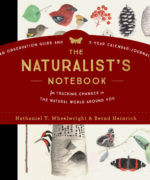The Naturalist’s Notebook: an Observation Guide and 5-Year Calendar-Journal for Tracking Changes in the Natural World Around You. / Nathaniel T. Wheelwright & Bernd Heinrich, 2017. Illustrations by Bernd Heinrich. Storey Publishing. 208 pages: includes journal pages, personal glossary pages and resources.

There may be an early winter advantage in getting close to nature. The Naturalist’s Notebook: an Observation Guide and 5-Year Calendar-Journal for Tracking Changes in the Natural World Around You, which is about getting close to nature, is a long title but it has a clear message. And it has the expectation that you use a specific type of journal, specifically a 5-year calendar-journal the authors have designed. Right away a reader can discern that there’s an authors’ promise of success (five years is a considerable amount of time, going forward), and that success is based on consistency and attentiveness.
The book’s presentation is charming, decorated with water-color illustrations and a wide ribbon, gold-edged pages and a place-marking red ribbon inside. Any time the cover of a book attracts me, I’m more than likely to pick it up and examine it—no matter the subject. And yet in this case, I have to admit I am attracted to natural subjects.
I’m aware that as humans we have an interest and an innate ability to monitor living beings in their surroundings. If our process is consistent, valuable knowledge is gained by actively looking at, listening to and recording their rhythms. A quote in The Naturalist’s Notebook… resonated with me:
… for millennia, indigenous peoples on every continent paid minute attention to the rhythms of nature…”.
It’s our human senses—sight, touch, smell, sound, taste—that allow us five ways of learning about the ecology of beings different from us, those on whom we might depend or defend ourselves against.
Since most of us don’t realize what that means, it may seem odd to “pay minute attention” to nature. It seems odd because we’re so removed from the vagaries of nature, inside climate-controlled buildings, eating food we purchase, our selection of clothing, entertainment, and the energy from electricity which makes our lives possible, as on-the-go as we are.
Yet proposing a change in venue—the space where we spend time—is just what The Naturalist’s Notebook… recommends.
So, what is a natural environment? And what about a “naturalist”—what or who qualifies to become one?
The authors provide chapters on “How to Become an Observant Naturalist I & II”; they discuss the tools needed, and they provide a process, such as posing questions and creating experiments before going out into nature.
Consciously leaving our high-tech environment and walking into a natural space to observe and take notes, we’re immersed in a new world that’s unfamiliar. It’s in constant change, which is why the closer we can get to it, the more our senses will be alert to its colors. Wheelwright and Heinrich encourage the reader to gather only the simplest tools for observation. They suggest not your digital tools, your smart phone or tablet, but simply paper notebook and pencil to record your findings.
Slowing down—their words, seen often enough these days—carries special meaning for the citizen scientist or natural observer. For without very close attention to the natural world, we’ll miss essential life processes and lose the chance to intuit about it and understand much.
Wheelwright and Heinrich say that your interest can be trained on animals or plants, birds, or the weather, for instance, in the natural environment you choose to become familiar with. They propose ways of becoming a naturalist, a scientist who discovers the natural world. These tips come from years of experience doing just as they suggest. They say:
If you are a beginning naturalist, overwhelmed by the diversity of life and unsure of where to start, I recommend looking at trees, insects, or birds—or all three if you feel ambitious.”
The authors’ careers as teachers of ecology gave them the opportunity to have years of study in natural environments in the temperate and tropical areas of the world. Yet they urge you to know that becoming a naturalist can be as simple as taking the time to observe and record in your neighborhood, an open space, a forest or at a river’s edge or oceanic shore.
The record can be a few notes and can include sketches. The whole process can take as much time as you have—from a few stolen minutes to hours, if you can manage that. What if you don’t draw? Well, you can take along a camera—as long as it’s not also a phone, etc. Just make it simple. Take your observations to the next step later and create illustrations in another notebook or journal.
And in the process of later transferring your notes or creating an illustration, you’re thinking and remembering the whole experience. This becomes a mindful and enduring engagement with the natural world.
It may be a particular advantage in picking up The Naturalist’s Notebook… now—in early winter—because the authors advise that winter is the season when it’s easiest to find life (just as in urban areas) and not be overwhelmed by it! And then you can utilize the 5-Year Calendar-Journal printed in the book, or model yours after theirs.
Books on natural subjects are usually accompanied by illustrations, most often pleasurable to look at. Illustrations show the delighted interaction between the subject and the artist who painted it. The illustrations in The Naturalist’s Notebook… are provided by one of the authors—Bernd Heinrich. His talent is significant. I like to think that if I began today, I could develop as much talent with practice!



